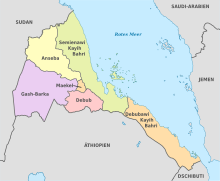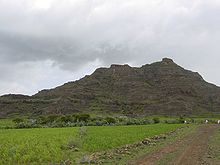Eritrea
![]()
The title of this article is ambiguous. For other meanings, see Eritrea (disambiguation).
Template:Infobox State/Maintenance/TRANSCRIPTION
Template:Infobox State/Maintenance/NAME-German
Eritrea ([ʔeʁiˈtʁeːa]; Tigrinya ኤርትራ Ertra, Erətra or Ertəra, Arabic إرتريا Iritriyā) is a state in northeastern Africa. It borders Sudan to the northwest, Ethiopia to the south, Djibouti to the southeast, and the Red Sea to the northeast. The country's name is derived from its Greek name Ἐρυθραία Erythraia, which derives from ἐρυθρὰ θάλασσα erythrà thálassa, German 'red sea', and was formerly dubbed Erythraea. The proper name Ertra (from Old Ethiopian bahïrä ertra, 'Red Sea') also refers to this ancient Greek name of the Red Sea. A quarter of Eritrea's population of nearly 6 million (2016) is concentrated in the capital region of Asmara; the other cities are much smaller.
Formerly in the highlands of Eritrea was the kingdom of Medri Bahri, with its capital at Debarwa, ruled by the Baher Negash; the lowlands of Eritrea were an Ottoman and Egyptian colony for more than 300 years, the capital being Massaua. In 1890 Eritrea became an Italian colony. From 1941 the country was under British administration, and from 1952 it was federally united with the then Empire of Abyssinia in personal union, before being centrally incorporated as the Province of Eritrea into the Ethiopian Empire of Haile Selassie in 1961. After a thirty-year war of independence, Eritrea became independent from Ethiopia in 1993.
In the 21st century, the country has a formally republican constitution and has been politically dominated since independence by the authoritarian Popular Front for Democracy and Justice, which emerged from the independence movement of the Eritrean People's Liberation Front. President since then has been Isayas Afewerki. With regard to the civil liberties of its citizens, Eritrea is heavily criticized by human rights organizations. The US-based non-governmental organisation Freedom House characterised Eritrea as a "hermetic police state" in its 2019 country report.
Geography
Physical geography
The almost desert-like dry savannah on the Red Sea is very hot and dry. In the highlands of the interior, on the other hand, up to 600 millimeters of rain fall annually, especially in the period from June to September. Most of Eritrea's major cities are found in the highlands, at over 1600 metres above sea level. The southern highlands are home to the country's few fertile regions, such as the Mendefera area, the environs of Badme, and the border triangle with Ethiopia and Sudan in the Gash-Barka region. Also the highest elevation of the country, the Dega with 3047 meters, southeast of Asmara, is located in the highlands of Abyssinia.
Eritrea also shares the Sahara in the west of the country: west of the Barka River and north of the Gash River, the eastern Sahara continues from Sudan and ends with the rise to the highlands of Abyssinia. The Eastern Sahara also reaches Eritrea in the northeast and continues along the coast until it ends at Massaua. Massaua is blessed with slightly more rainfall compared to other coastal towns in the region such as Port Sudan and Assab.
In the border area with Djibouti, Eritrea has a share in another desert: on the southern coast, in the area of Assab, lies the Danakil Desert, one of the hottest and driest deserts in the world. The Danakil Depression is home to the country's lowest point, 110 metres below sea level.
Human Geography
Cities
The largest cities are (2012 calculation): Asmara 665,000 inhabitants, Assab 99,000 inhabitants, Keren 80,000 inhabitants, Massaua 52,000 inhabitants, Mendefera 25,000 inhabitants and Barentu 19,000 inhabitants.
See also: List of cities in Eritrea
Management structure
Until 1996, Eritrea was divided into nine regions (awraja). These regions dated back to the Italian colonial period and their regional capitals were Akkele Guzay (Adi Keyh), Barka (Agordat), Denkalia (Assab), Gash Setit (Barentu), Hamasien (Asmara), Sahel (Nakfa), Semhar (Massaua), Senhit (Keren) and Seraye (Mendefera).
The administrative reform of 15 July 1996 reduced the number of regions (zoba) to six:
- Maekel (Central Region) (Asmara)
- Debub (South Region) (Mendefera)
- Gash-Barka (Barentu)
- Anseba (Keren)
- Semienawi Kayih Bahri (Northern Red Sea Region) (Massaua)
- Debubawi Kayih Bahri (Southern Red Sea Region) (Assab)

Map of the administrative regions of Eritrea
Social
Education
Since independence, great progress has been made in the education sector: Literacy levels for people aged 15-24 were among the highest in sub-Saharan Africa in 2015 at 93% (2002: 78%).
Formally, school attendance is compulsory for children between the ages of 7 and 13, but only between 39 and 57 percent of those of compulsory school age attend primary school, and only around 21 percent attend secondary school. The schools are poorly equipped, with average class sizes of 63 (primary schools) and 97 (secondary schools) pupils per class. Girls are clearly disadvantaged. The proportion of illiterates is 30 percent.
Health
Health care is largely financed by the state and is free of charge for people with a poverty certificate.
Life expectancy is estimated at 63.4 years in 2010-2015. The fertility rate was 4.7 children per woman in 2012. The infant mortality rate is 74 per 1000 live births, ranking Eritrea 51st in the world. Maternal mortality was reduced by 75% between 1990 and 2013.
In 2002, almost 89% of women between the ages of 15 and 49 were still affected by female genital mutilation, compared to 94.5% in 1995. The success of the educational work was more clearly demonstrated by the prevalence among daughters, which was also surveyed in 2002, ranging from 40% to 67.5%, depending on the level of education of the mothers, with an average of 62.5%. On 31 March 2007, a legal ban on female circumcision came into force.
| Development of life expectancy | |||
| Period | Life expectancy | Period | Life expectancy |
| 1950–1955 | 34,1 | 1985–1990 | 48,7 |
| 1955–1960 | 36,7 | 1990–1995 | 50,8 |
| 1960–1965 | 40,1 | 1995–2000 | 54,0 |
| 1965–1970 | 42,1 | 2000–2005 | 56,7 |
| 1970–1975 | 44,1 | 2005–2010 | 60,7 |
| 1975–1980 | 45,9 | 2010–2015 | 63,4 |
| 1980–1985 | 47,3 | ||
Source: UN
Media
See also: Freedom of the press in Eritrea
Eritrea's media is state-run. There is the newspaper New Eritrea (ሓዳስ ኤርትራ Ḥaddas Erətra = ارتريا الحديثة Iritriya 'l-ḥadīṯa = ኤሪትርየ ሐዳስ Eritrəya ḥaddas), the radio stations Voice of the Masses (ድምጺ ሓፋሽ Dəmṣi ḥaffaš = صوت الجماهير Ṣaut al-ǧamāhīr), Zara FM and Radio Numa, and the television station ERi-TV.

Field with teff in the highlands during the rainy season in July
Search within the encyclopedia